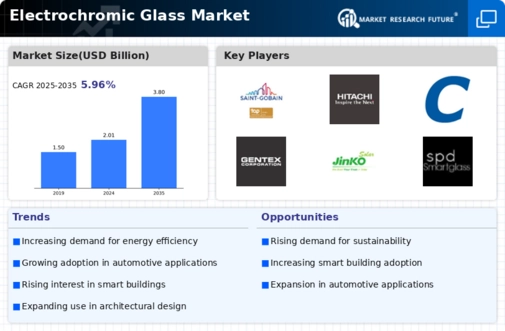Top Industry Leaders in the Electrochromic Glass Market
 Electrochromic glass, also known as smart glass, is rapidly transforming the way we interact with light and temperature in buildings, vehicles, and even consumer electronics. This innovative technology, which allows glass to change its tint or transparency electronically, But who are the key players in this dynamic space, and what strategies are they adopting to carve out their share in this burgeoning market?
Electrochromic glass, also known as smart glass, is rapidly transforming the way we interact with light and temperature in buildings, vehicles, and even consumer electronics. This innovative technology, which allows glass to change its tint or transparency electronically, But who are the key players in this dynamic space, and what strategies are they adopting to carve out their share in this burgeoning market?
Strategies Adopted:
-
Product Diversification: Leaders like Gentec and SageGlass are expanding their offerings to cater to diverse applications, from architectural windows to automotive sunroofs. Saint-Gobain's recent launch of SageGlass Harmony, with its enhanced color options and faster switching speeds, exemplifies this trend. -
Vertical Integration: Players like PPG and ChromoGenics are integrating manufacturing processes to gain control over the supply chain and reduce costs. This can lead to more competitive pricing and improved product quality. -
Regional Expansion: Companies like EControl Systems are focusing on untapped markets like Asia-Pacific, spurred by the region's rapid infrastructure development and growing demand for energy-efficient solutions. -
Partnerships and Collaborations: Strategic alliances are becoming crucial for expanding reach and expertise. For instance, Gentec partnered with Samsung Display for the development of electrochromic displays for smart devices. -
Innovation and R&D: Continuous investment in research and development is vital to stay ahead of the curve. Companies are exploring new materials, coatings, and manufacturing techniques to improve efficiency, durability, and affordability of electrochromic glass.
Factors for Market Share:
-
Technology Leadership: Continuous innovation in electrochromic materials, switching speeds, and control systems is crucial for differentiation. Players who invest heavily in R&D and hold key patents will hold a competitive edge. -
Cost Reduction: Affordability remains a major barrier to wider adoption, particularly in residential and automotive applications. Players who can optimize manufacturing processes and material costs will gain traction. -
Application Focus: Targeting specific applications with tailored solutions can unlock new market segments. For example, offering self-dimming windows for trains or dynamic displays for retail spaces can create niche opportunities. -
Sustainability and Energy Efficiency: Electrochromic glass's ability to reduce energy consumption and improve thermal comfort resonates with environmentally conscious consumers and businesses. Players who effectively highlight these benefits will stand out.
Key Players
- SAGE Glass, Inc.(U.S.),
- ChromoGenics AB (Sweden),
- RavenBrick LLC (U.S.),
- Asahi Glass Company (Japan),
- Gentex Corporation (U.S.),
- PPG Industries (U.S.),
- Magna Glass & Window, Inc. (U.S.) ,
- Guardian Industries Corporation (U.S.),
- PPG Industries (U.S.),
- View, Inc. (U.S.)
Recent Developments :
January 2023: PPG Industries announces its entry into the electrochromic glass market with a focus on large-scale architectural applications.
February 2023: A research team at MIT develops a new electrochromic material with exceptional switching speed and long lifespan, potentially revolutionizing the market.
March 2023: The European Union announces new regulations incentivizing the use of energy-efficient building materials, including electrochromic glass.










